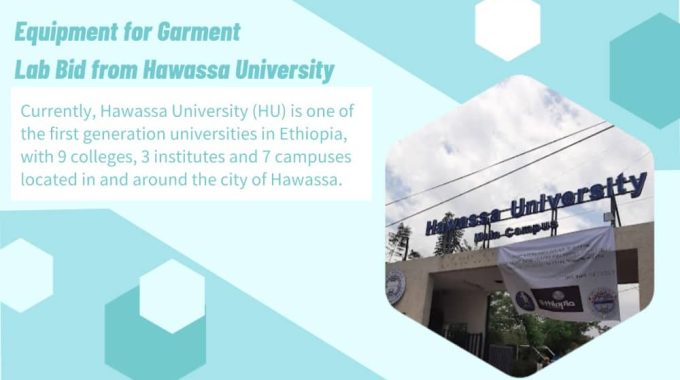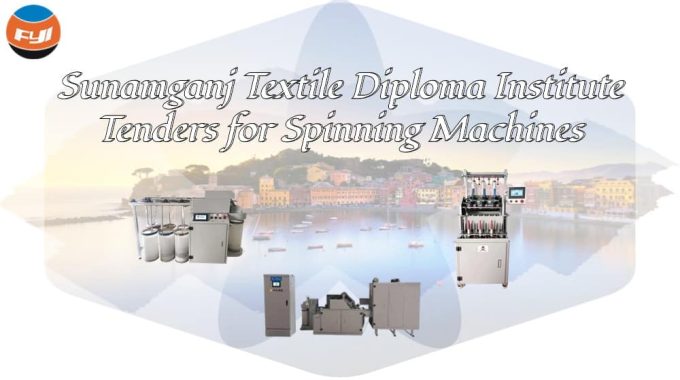
Tender for Leather Tester at The Federal Technical and Vocational Training Institute
Contents
Tenderer
Federal Technical and Vocational Education and Training Institute (FTVETI) was established in 2011 by The Council of Ministers Proclamation 245/2011 to produce highly professional and technically efficient TVET teachers and leaders. The driving force for establishing FTVETI , among other things , was that there were no institution to train competent and sufficient technical and vocational teachers and leaders based on the outcome based system and occupational standards.
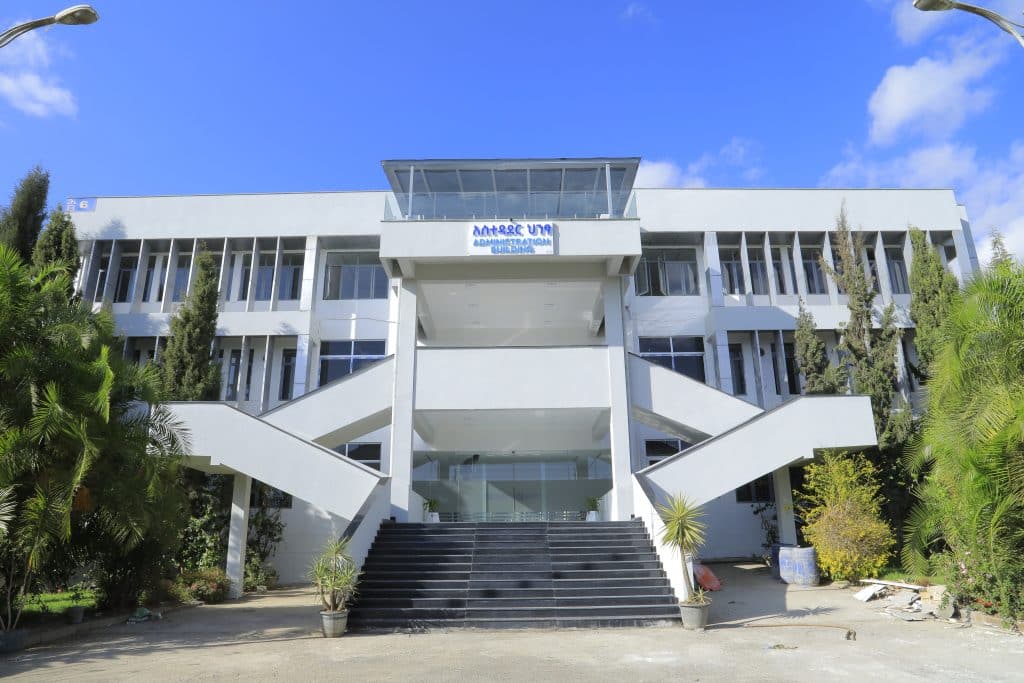
Request for the bids
SPECIFIC PROCUREMENT NOTICE
Country:- FEDERAL DEMOCRATIC REPUBLIC OF ETHIOPIA
Name of Project:- East Africa Skills for Transformation and Regional Integration Project (EASTRIP)
Contract Title:- Procurement of Laboratory Equipment and Workshop Machineries.
Credit No.: IDA-6335-ET
RFB Reference No.: ET-ET FEDERAL TI-376937-GO-RFB
Here are some machine requirements related to leather tester:
Soling materials abrasion machine
Introduction
Soling materials abrasion machine designed to test rubber and urethanes to assess their resistance to abrasion in normal every day wear. The main function of abrasive tester is to test the friction of surface by a particular piece of sandpaper, after friction for a certain time, and then assess the condition of material surface, weight, volume and thickness, from this standard to assess the abrasive nature of materials. A 150mm diameter drum is rotated at 40rpm by a precision AC motor with variable speed control. A sheet of specified P60 abrasive paper fixed to the drum by double-sided adhesive tape. A cylindrical sample, of fixed dimensions, is inserted in the sample holder and its protrusion adjusted and set using the integral micrometer. The sample holder either fixed or rotating travels over the surface of the abrasive paper at 0.32m/sec under a loading of either 5 or 10 newton for a set distance. An adjustable rotary cam allows the sample to travel 10, 20, 30 and 40 meters. Machine should have self-tracking suction head which can be connected to a standard vacuum cleaner, removing the need for constant operator attention. A sample cutting knife should be provided and suitable for use with rotary pillar drill. Standards: SATM, ISO, DIN, SATRA.
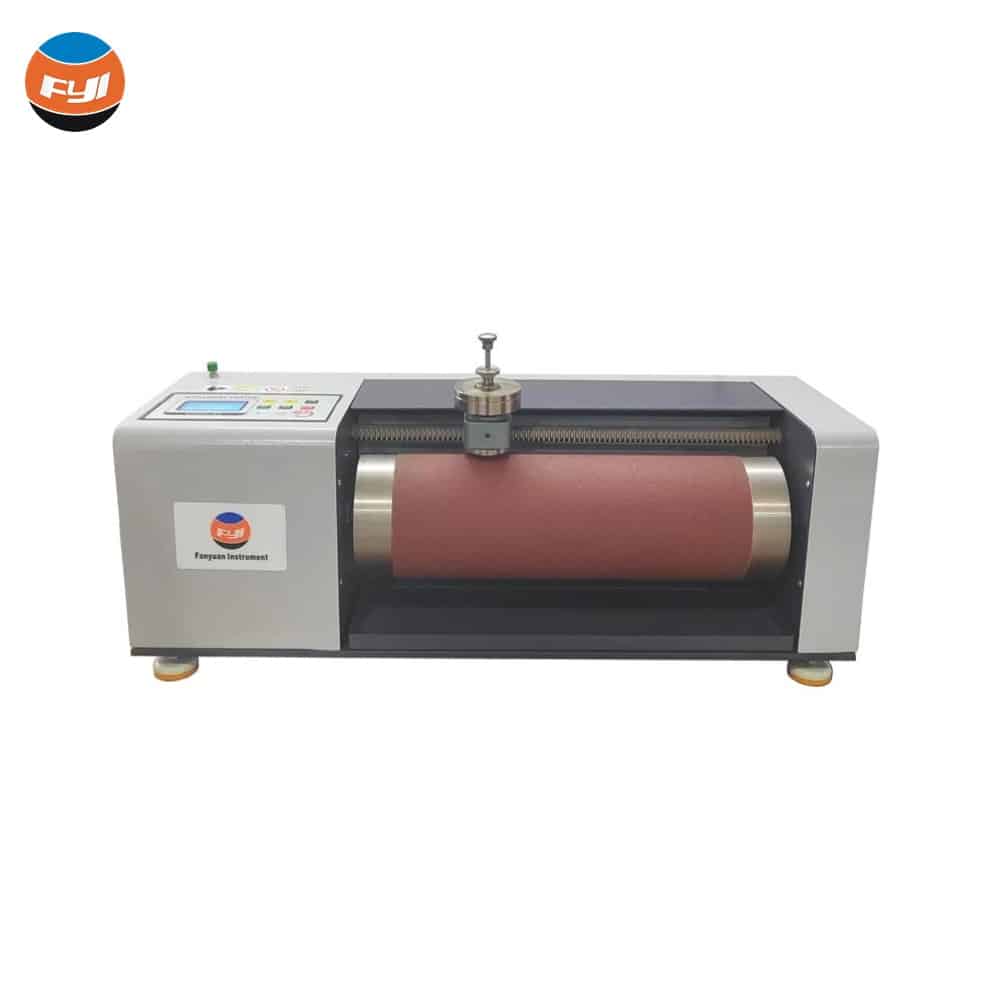
Features
Test-arm weight: ± 5 (g)
Specimens size: Φ16±0.2mm, 6-14mm (thickness)
Specimen load: 2.5N, 5N, 10N
Shift screw: 6 teeth / inch
Horizontal displacement: 4.2mm / rotate
Fixture lateral displacement: 4.2mm/wheel each lap
Wheel diameter: 150mm±0.2
Wheel length: 460mm
Wheel rotate speed: 40±1r/min
Travel reservations: 40m/20m
Grinding Wheel: # 40
Testing length: 40M (about 84 rotate)
Set rotation: 84 rotate (about 40M)
Abrasion speed: 0.32m/sec
Dip angle: 3° the angle of the specimen back shaft with vertical roller face
Testing angle: 15° (adjustable)
Emery paper: 60 #, 425 ±473 ±1.5 to 2 (mm)
Dimension:(70 ×450 ×450) cm
Machine weight: 60 to 75 Kgs
Counter: LCD displayer 6 digit auto-brake device, With automatic steel cleaning brush wheel
Power Supply: AC 220±10%, 50Hz/ 60Hz
Drive Power: 40W; 1/30
Power consumption :400w
Return form: Electric automatic reset.
Structure
The abrasion machine shall basically consist of three a laterally movable test piece holder and a rotatable cylinder to which a specified abrasive paper is fixed. The test piece holder shall consist a cylindrical opening, the diameter of which can be adjusted and has a device for adjusting the length of the test piece protruding from the opening to 2mm.The test piece holder is mounted on a swivel arm, the center axis of the holder has an inclination of 3oc to the perpendicular in the direction of rotation and the center of the test piece to be abraded shall lie within 1mm directly above the longitudinal axis to cylinder. The test piece shall be pressed against the abrasive cloth with a force of 10N and the lateral displacement is approximately 4.2mm per revolution of cylinder so that test piece shall traverse only four times across the same area of the abrasive cloth. The test must automatically stop at the end of the abrasion distance.
Consumables
Certified rubber: The certified abrasion rubber is used to check the abrasion machine is performing correctly. A single sheet (186mm x 186mm x 8mm) rubber.
Abrasive Paper: a standard 60 grit abrasive paper specifically for the abrasion test machines. A single sheet (473mm x 400mm) abrasive paper. General requirement: this equipment shall be used to assess the abrasion of elastomers subject to wear by abrasive action.
Accessories
Cutting die /hollow drill, Cylindrical in shape, of diameter 16mm ± 0.2mm, with a minimum height of 6mm,
Analytical Balance: Accuracy ±1mg, capacity 1kg.
Additional requirements
- The machines have to be international certificate equipped with all characteristics of actual rules.
- Electrical Supply connections: Matching to Ethiopian supplies (230 volts/50hz).
- Warranty: at least 2 years, service for at least 2 years.
- Installation, commissioning and basic operational training includes the following aspects: Use on the equipment, Calibration procedures, External maintenance of the equipment, Safety procedure.
- Documentations in English language, which covers the following aspects: Service and maintenance manual, International standard test method, User manual, Test specimen preparation procedure, Test procedure and its standard, Instructions for routine use and maintenance, Statement of performance characteristics, Health and safety information (optional), Service and maintenance manual.
- Instrument shall be new (refurbished equipment will not be accepted), Manufactured date/month/year, Manufacturer, Model, Origin should be clearly mentioned.
Whole sole flexing machine
Whole sole flexing machine is designed to determine the resistance of materials to cut growth during repeated flexing. It is especially applicable to outsoles of footwear including sole constructions. The machine has three workstations presented horizontally for operator ease. Loading, unloading and measurements are also much easier to carry out with the workstations presented in this manner. Samples are set at 140 flexes per minute and the number is recorded on a counter which has the facility to pre-set the number of flexes required. A jig is available and is used to locate the chisel and support the test while the initial chisel cuts are made. All moving parts requiring access are protected by a fully interlocked safety guard, ensuring the machine conforms to the latest safety regulations. A manual device to measure the stiffness of outsole may be required to see if outsole must be flexed in accordance with international standards. Standards: SATM, ISO, DIN, SATRA
Features
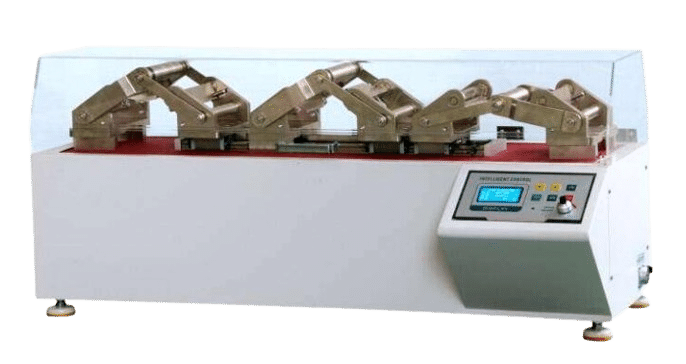
Bending angle: 90 degrees
Bending speed: 125-150/min (Speed adjustable)
Diameter of mandrel: 30mm
Width of clamp: 144mm
Counter: LCD 0-999999
Contemporary test: 3 Samples
Sole Flexibility Tester: 0-50N
Dimensions (L X W x H) cm: (105x53x30) cm
Weight: 100kgs
General requirement: to determine the flex resistance of outsole, in according to international standards. The instrument clamp at least 3 test places, angle of flex 90, flexing mode vertical type, electronically controlled with at least the number of cycles, adjustable speed of the movement, supplement for the proper and easy attachment of the specimens in the specimen holders.
Accessories
Chisel (Cutting tool), to pierce the outsole, Mandrel of diameter (30±0.1) mm, optical magnifier with an accuracy of 0.1mm. All necessary spare parts kit for running the instrument and maintenance (i.e set of Alen key).
Additional requirements are the same as for the Soling materials abrasion machine.
Shoe lace abrasion machine (Lace to eyelet method)
Shoe lace abrasion machine is designed to test the abrasion resistance of lace to eyelet (shoe lace to repeated rubbing to eyelet). This method utilises a standard eyelet mounted on a rigid board and the lace to be tested. Laces should be stored in a standard controlled atmosphere for at least 48 hours before testing.
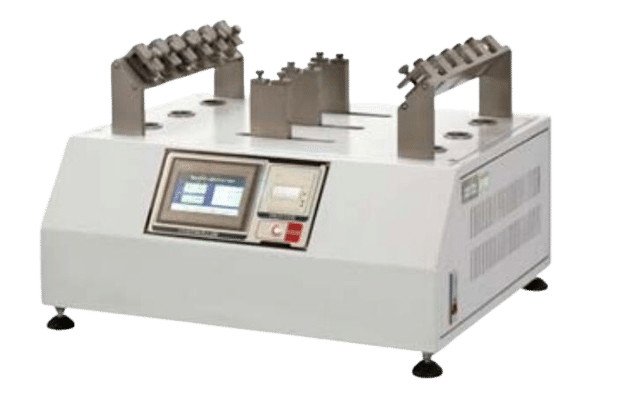
The equipment has six stations for testing laces. Eyelets affixed to rigid boards are placed in the holders provided. One end of the lace to be tested is clamped in a carrier and the other end is passed through the eyelet and then fixed to a weight capable of applying a tensioning force of 4.46N to the lace. The machine moves each lace a distance of 75mm through the eyelet at 100 cycles per minute. The movement of the carrier causes the lace to rub in the eyelet. Each station has a separate counter and, when a lace breaks, the count is stopped on that station. When all six laces have broken, the machine will stop. This machine should be used to test eyelets against standard shoelaces or alternatively shoelaces against standard eyelets. Standards: SATM, ISO, DIN, SATRA.
Features
Sampling: 6 group
Weight: 455±5g
Stroke: 76±2 mm
Eyelets Ф: 4.5mm
Speed: 100±5 times/min
Fiber board (L x W x T): (25 × 25 × 3) mm
Dimension (L x W x H) cm: (55 × 56 × 40) cm
Weight: 62 kg
Power: 220V, 50Hz
General requirement: a set (six stations) of stationery clamps, a set of movable clamps at 280 ± 50 mm minimum separation 310 (D) for maximum separation of 35 ± 5mm to one side of stationary clamp apply, a force of 2.45 ± 0.03N (50 ± 3 g) vertically from lower end of the lace. Movable clamp moves a distance of 35 ± 2mm at a rate of 60 ± 6 cycles/minutes. A counter is attached at each station and a set counter attached in the m/c.
Separately standard eyelets, with the following characteristics: construction visible (standard /flat) type
Material type: brass
Nominal internal barrel diameter:4.5mm
Nominal overall length:5.5mm
Accessories: all necessary spare parts kit for running the instrument and maintenance.
Additional requirements are the same as for the Soling materials abrasion machine.
There are many machines related to leather tester that are not listed, and interested readers can contact us to obtain them.
